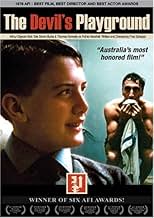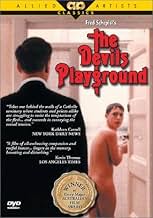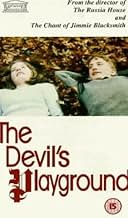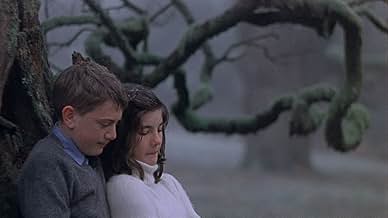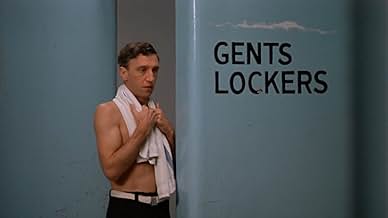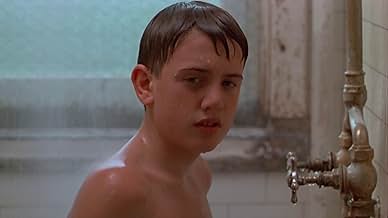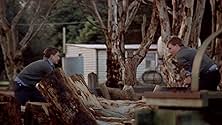The Devil's Playground
- 1976
- 1 घं 47 मि
IMDb रेटिंग
6.8/10
1.4 हज़ार
आपकी रेटिंग
अपनी भाषा में प्लॉट जोड़ेंFred Schepisi's first feature is this lushly photographed period drama detailing a young boy's coming-of-age in a strict Catholic seminary in 1950s Australia.Fred Schepisi's first feature is this lushly photographed period drama detailing a young boy's coming-of-age in a strict Catholic seminary in 1950s Australia.Fred Schepisi's first feature is this lushly photographed period drama detailing a young boy's coming-of-age in a strict Catholic seminary in 1950s Australia.
- पुरस्कार
- 6 जीत और कुल 5 नामांकन
फ़ीचर्ड समीक्षाएं
I have this film as part of my home video collection and have not seen it in awhile. However, I can remember the feeling of misgiving I felt for these young men who were entering puberty. It brought back memories of my entrance into the same. It brought to mind that those things for which we are regularly exposed to do not cause so much curiosity. These young boys were required to remain sexless without feelings or hormones, just when their bodies were beginning to take off. I kept thinking that it could have helped them if they were taught about the normal body development they could expect, the urges and ideas which may spring to mind. The allowance of the natural arrangement of public showering, with the nudity exposure indicated, but allowance for one's privacy and dignity as the person is comfortable, could also have helped in their adjustment to puberty. Of course, this was a movie, but it is a good lesson to anyone dealing with pubescent kids. Simon Burke was excellent in his portrayal of his character.
One of my best friends at university had attended a Catholic brothers' seminary and like Fitz in "The Devil's Playground" had been dismissed from it due to his increasing interest in the opposite sex. Like Tom, he was confronted with letters sent to him from a girl he had met on a camp that the brothers had read and found disturbing. When my friend saw "The Devil's Playground" back in 1976, he commented that the film was realistic except for the fact that many of the lines spoken in the film would have remained in the minds of the brothers and the boys but never spoken.
The film itself is a masterpiece. The casting is perfection from that of the brothers down to the most minor characters. Watch for Danee Lindsay as Lynette. She has very few minutes on screen but her charm and warmth jumps off the screen at you. When she steals a kiss from Tom, she steals one from the audience. This is no sexually precocious 13 year old. This is a genuine 1950's Australian lass right down to her crooked front tooth that somehow adds to her appeal. How sad when Tom's innocently affectionate letters to her are used as evidence of something almost distasteful and to be discontinued lest Tom jeopardize his vocation. Tom Keneally as Father Marshall is equally effective. Again a small role that hits a home run. He is a cheerful and good man but this only makes his terrifying speech prior to the three day retreat even more disturbing. His depiction of hell, its terrors and its time span have remained with me – an atheist – throughout my life. If it remains with me, I can only guess at the effect it had on boys like those in the film.
The cinematography and the score add to the pervasiveness of the unease. There are very few shocks – just a sense of something being off kilter. Here is a struggle against an inexorable psychological enemy not some visible monster that jumps out of the shadows. Tom Allen, the young protagonist, struggles to remain positive about becoming a brother in the face of fanaticism, sadism, overly strict prohibitions and the onset of puberty with its embarrassments and confusion. When he finally runs away, there is a true sense of relief for him and for us as we have become involved in his struggle. What a wonderful performance by the young Simon Burke.
The struggles of all the brothers are presented in a balanced manner. Each of them is likably human and each, with the exception of Brother Francine, struggles with their belief in the rules and regulations they enforce. Even Brother Francine, as played by Arthur Dignam, plays a beautifully solemn piano piece which seems to reflect a sensitive side to an ostensibly repellent character. His fanaticism is indicative of his fear that any doubt might bring about a complete breakdown of his beliefs. And once he does doubt, the floodgates do open and all is lost.
Having taught teenagers for over 30 years, I have come to understand how much childhood stays with us throughout the rest of our lives. It makes me wonder whether Tom would ever be truly free from guilt. "Give me a boy until he is seven, and he is mine for life." What a terrible boast to make but an accurate observation of how enduring is childhood indoctrination.
The film itself is a masterpiece. The casting is perfection from that of the brothers down to the most minor characters. Watch for Danee Lindsay as Lynette. She has very few minutes on screen but her charm and warmth jumps off the screen at you. When she steals a kiss from Tom, she steals one from the audience. This is no sexually precocious 13 year old. This is a genuine 1950's Australian lass right down to her crooked front tooth that somehow adds to her appeal. How sad when Tom's innocently affectionate letters to her are used as evidence of something almost distasteful and to be discontinued lest Tom jeopardize his vocation. Tom Keneally as Father Marshall is equally effective. Again a small role that hits a home run. He is a cheerful and good man but this only makes his terrifying speech prior to the three day retreat even more disturbing. His depiction of hell, its terrors and its time span have remained with me – an atheist – throughout my life. If it remains with me, I can only guess at the effect it had on boys like those in the film.
The cinematography and the score add to the pervasiveness of the unease. There are very few shocks – just a sense of something being off kilter. Here is a struggle against an inexorable psychological enemy not some visible monster that jumps out of the shadows. Tom Allen, the young protagonist, struggles to remain positive about becoming a brother in the face of fanaticism, sadism, overly strict prohibitions and the onset of puberty with its embarrassments and confusion. When he finally runs away, there is a true sense of relief for him and for us as we have become involved in his struggle. What a wonderful performance by the young Simon Burke.
The struggles of all the brothers are presented in a balanced manner. Each of them is likably human and each, with the exception of Brother Francine, struggles with their belief in the rules and regulations they enforce. Even Brother Francine, as played by Arthur Dignam, plays a beautifully solemn piano piece which seems to reflect a sensitive side to an ostensibly repellent character. His fanaticism is indicative of his fear that any doubt might bring about a complete breakdown of his beliefs. And once he does doubt, the floodgates do open and all is lost.
Having taught teenagers for over 30 years, I have come to understand how much childhood stays with us throughout the rest of our lives. It makes me wonder whether Tom would ever be truly free from guilt. "Give me a boy until he is seven, and he is mine for life." What a terrible boast to make but an accurate observation of how enduring is childhood indoctrination.
A fine early example of Fred Schepisi's directing style. The film is more than 20 years old but is still fresh. Some strong acting performances, particularly from Nick Tate and young Simon Burke and Arthur Dignam as the tortured Br Francine. Watch for a cameo performance from Tom Keneally, the author of Schindler's List.
There's one piece of inspired casting: Tom Kenneally (who looks like a jolly monk) as the visiting priest who looks like a jolly monk. Kenneally isn't an actor. (He's an Australian writer, best known overseas as the author of "Schindler's Ark", retitled "Schindler's List" in the US.) In fact, a non-actor suits the part well: like Kenneally, the priest arrives at the school performing his priest act competently but without polish. Like Kenneally, his native charm shines through, even when he's giving an appalling speech about Hell. You find yourself wondering: is he REALLY serious? And you have no way of telling.
That's all that's truly inspired about Schepisi's film. The story takes place at some kind of young-priests-to-be training college, only for a long time it looks as though there is no story at all: instead we get slice after slice of life, and it's a while before we can tell all the characters apart and work out which ones we're meant to be following. Telling a story in this way requires razor precision; every single scene must be inherently interesting AND perfectly crafted. No scene (with one possible exception) is. On the other hand, no scene really falls down, either. This is the kind of reasonably absorbing movie (after the initial boring bits) that's well worth the time it takes to watch - i.e., an hour and a half. (And it's even worth the time spent thinking about afterwards.) There's a difference between satisfaction and pleasure; a film like this is satisfying, and ... well, not UNpleasant. If only the title didn't promise something BIG.
That's all that's truly inspired about Schepisi's film. The story takes place at some kind of young-priests-to-be training college, only for a long time it looks as though there is no story at all: instead we get slice after slice of life, and it's a while before we can tell all the characters apart and work out which ones we're meant to be following. Telling a story in this way requires razor precision; every single scene must be inherently interesting AND perfectly crafted. No scene (with one possible exception) is. On the other hand, no scene really falls down, either. This is the kind of reasonably absorbing movie (after the initial boring bits) that's well worth the time it takes to watch - i.e., an hour and a half. (And it's even worth the time spent thinking about afterwards.) There's a difference between satisfaction and pleasure; a film like this is satisfying, and ... well, not UNpleasant. If only the title didn't promise something BIG.
This was a very thought provoking film for me and after several years I'd love to see it again (I've seen it twice on TV). The young hero was so natural I felt I knew him, and he had a very likable personality. The two monks in mufti enjoying a night on the town were more down to earth and likable than most of the other monks at the Catholic boarding school and after successfully picking up two women in a pub they got cold feet! It was interesting to see how another monk who seemed very emotionally cold dealt with a trip to a mixed gender public swimming baths, and the amazing erotic dream he had afterwards. The subjects of troubled adolescence and religious repression were well explored. The film hasn't dated at all. I hope someone brings this out on a DVD.
क्या आपको पता है
- ट्रिवियाThis picture was one of fifty Australian films selected for preservation as part of the National Film and Sound Archive of Australia's Kodak / Atlab Cinema Collection Restoration Project.
- साउंडट्रैकThe Anniversary Waltz
(uncredited)
Written by Dave Franklin and Al Dubin (uncredited)
[sung at the picnic by the Allen family when they visit Tom at school]
टॉप पसंद
रेटिंग देने के लिए साइन-इन करें और वैयक्तिकृत सुझावों के लिए वॉचलिस्ट करें
- How long is The Devil's Playground?Alexa द्वारा संचालित
विवरण
- रिलीज़ की तारीख़
- कंट्री ऑफ़ ओरिजिन
- आधिकारिक साइटें
- भाषा
- इस रूप में भी जाना जाता है
- Прибежище Дьявола
- फ़िल्माने की जगहें
- उत्पादन कंपनियां
- IMDbPro पर और कंपनी क्रेडिट देखें
बॉक्स ऑफ़िस
- बजट
- A$3,00,000(अनुमानित)
- चलने की अवधि1 घंटा 47 मिनट
- ध्वनि मिश्रण
- पक्ष अनुपात
- 1.85 : 1
इस पेज में योगदान दें
किसी बदलाव का सुझाव दें या अनुपलब्ध कॉन्टेंट जोड़ें


